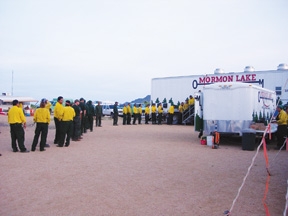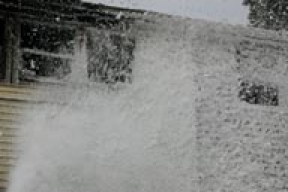 |
| Bruce Bacher starts the painstaking task of applying reflective dots to Engine 1 one at a time. The ultimate motivation and reward: firefighter safety. (Photos by author unless otherwise noted.) |
 |
| Ten hours later, a completed Engine 1 sits with its new stripes in ambient light. |
 |
| The completed Engine 1 was also shot using flash photography. |
 |
| SCENEdots are placed between the raised surfaces of the diamond plate tread panels. |
 |
| Chief Bobby Bunnell and Battalion Chief Tony Atwood with Ladder 2’s new stripes in ambient light. The GFD creatively found extra dollars in a tight budget to meet the intent of NFPA 1901 by retrofitting existing fire apparatus. |
 |
| Ladder 2 is shown with its new stripes at night with flash photography. The chevrons, created by a series of reflective dots, make this apparatus visible at night, maximizing scene safety for Glasgow firefighters. (Photo by Captain Tracy Shirley, Glasgow Fire Department.) |
I recently had the privilege to teach my new class “Company Drills You’re Not Going to Find in the Books” in Glasgow, Kentucky. The historic city of Glasgow was founded in 1799 in the south central part of Kentucky. The Glasgow (KY) Fire Department (GFD) was established in 1884 as a bucket brigade. Whenever a fire was reported, a local hardware store was opened and the buckets were brought out, with water being used from the big spring located just off the square. Today the GFD, under the leadership of Chief Bobby Bunnell, protects a population of 14,200 and 14.8 square miles of the Bluegrass State. Thirty-three of the 45 employees are uniformed firefighters. The department runs three engines, a quint with a 50-foot teleboom, an E-One 75-foot rear-mount aerial, and a rescue truck out of two fire stations. It also has a new training tower where it can conduct live fire training.
As Bunnell was giving me the grand tour, our conversation turned to the budget crunch that every fire department, including my own, is feeling. He was racking his brain trying to come up with creative ways to save a dime. He wasn’t even sure he was going to be able to afford diesel fuel for the fire trucks within the current budget. He was going to have to revisit the budget and reprioritize expenditures just to cover fuel costs. I was witnessing the budget process from a different perspective. If my rig, Ladder 6, needs diesel fuel, we pull up to the pump at the station and fill ’er up. Before, if we were low on fuel, we would call the fuel desk and it would set up an immediate delivery. Now, we don’t even have to do that; the deliveries are automatic. We don’t even give it a second thought. Now I was looking at the man responsible for paying the bills.
As we returned to the main station, there was a group of firefighters huddled at the rear of Engine 1. They were watching Bruce Bacher, a volunteer firefighter from Gott VFD in Warren County, Kentucky, put “dots” on the back of the engine. He was constructing reflective chevron patterns one dot at a time! I had heard about this process but had never actually seen the product. Bunnell mentioned that GFD’s newest rig, Engine 3, is a 2010 Pierce Contender that came with factory-placed reflective chevrons on the rear of the apparatus—a new requirement in NFPA 1901, Standard for Automotive Fire Apparatus, (2009 edition).
The standard states in Section 15.9.3: “At least 50 percent of the rear-facing vertical surfaces, visible from the rear of the apparatus, excluding any pump panel areas not covered by a door, shall be equipped with retroreflective striping in a chevron pattern sloping downward and away from the centerline of the vehicle at an angle of 45 degrees.” But, it is not retroactive and only applies to new apparatus purchased after January 1, 2009.
Putting reflective chevron striping on emergency vehicles is a practice that originally started in Europe. Studies showed a significant reduction in the number of accidents involving parked fire and EMS apparatus and inattentive drivers in oncoming traffic.
According to Bunnell, “We found the reflective chevrons on the new engine were a profound improvement over the visibility of the existing fleet, especially at night. When I respond on alarms in the evening, I can easily see the chevrons and say to myself ‘There’s Engine 3’. That’s something I’ve never noticed before. I remember noticing the reflective chevrons on the ambulances here in Glasgow (EMS is provided by Barren-Metcalfe County) and saying to myself, ‘We need to get some of those.’ After the delivery of Engine 3, my command staff and I were a little uneasy that one engine crew was better protected than the others from oncoming vehicular traffic. The GFD responds to approximately 120 motor vehicle/highway incidents per year. That’s a combination of accidents, rescues, and vehicle fires. Bottom line—that’s 120 times my personnel are exposed to oncoming traffic. I want to give them every tool and accessory I can afford to make sure they can successfully mitigate the emergency and get back to quarters safely.
“My job is to make sure I provide the greatest safety margin possible and put as many safeguards in place so my guys can concentrate on doing their job. I want them to know I’m watching their back. When I met Bruce and he dropped off a brochure about these reflective dots that could be applied to older apparatus, he had our attention. I was able to scrounge up an extra $600 and, thanks to Bruce, we were able to retrofit one more engine and our ladder truck with reflective striping using these adhesive reflective dots.”
On Bacher’s workbench was a stack of sheets with a multitude of reflective dots in a variety of colors. The reflective vinyl is made by 3M. The company uses a new Diamond Grade™ reflective vinyl that is four times brighter than regular reflective vinyl. Cutting the sheets into dots gives a distinctive LED appearance on the final product compared to a regular solid stripe. The sheets come in orange, yellow, green, red, white, and blue. The dots are weatherproof, and the edges are sealed to prevent moisture and dirt contamination. They have a five- to seven-year lifespan and can simply be replaced with a single dot. Dots can be removed by using a heat gun, a hair dryer, or acetone. Peeling them off will cause the dots to fragment similar to car tabs applied to license plates.
What impacted me the most on this project was the amount of time Bacher put into this endeavor. He created these reflective chevrons placing one dot at a time! That’s incredible patience. He put in two 10-hour days and ended up placing 2,200 dots on Engine 1 and 2,130 on Ladder 2. After some quick calculations in my head (OK, I used a calculator), that comes out to 14 cents per dot! Well $300 a day sounds better, but still. He didn’t do this because he’s getting rich. He did it as a labor of love—love for his fellow firefighters and a concern for their safety. How can you put a price on that?
When the job was complete, it was time to take pictures of the finished product. We were all impressed by how well the reflective chevrons showed up in daylight—not imposing but noticeable. But at night, or with a flash? Impressive for a retrofit. These reflective vinyl dots are made by SCENEdots (www.scenedots.com). In the beginning, all the dots had to be placed on one at a time. It was an “all hands” effort. Now, the dots are available on chevron sheets that can be placed right on the diamond plate panels covering a larger area in a single application. Departments on shoestring budgets can look at this aftermarket product to accomplish the intent of NFPA 1901 on older apparatus for just pennies on the dollar. It’s rare to find a product that for pennies can greatly increase the safety margin for firefighters.
If firefighters are our most valuable resource, then let’s protect them. Bunnell and Bacher demonstrated that a little money and hard work can go a long way. It’s their dedication and commitment to firefighter safety that’s the real story here. I’m sure it’s the best $600 that Bunnell ever spent.
RAUL A. ANGULO, a veteran of the Seattle (WA) Fire Department and captain of Ladder Company 6, has more than 30 years in the fire service. He is on the Board of Directors for the Fellowship of Christian Firefighters. He lectures on fire service leadership, company officer development, and fireground strategy and accountability throughout the United States, Canada, and Mexico.
More Fire Apparatus Current Issue Articles
More Fire Apparatus Archives Issue Articles

